You have decided to get rid of your tattoo and have opted for the laser removal process near Mulhouse. Congratulations on your decision! Now, you are wondering what are the best practices for quick recovery after this treatment. Don’t worry, we’ve got the answers!
In this article, we’ll walk you through the best practices to help speed up the recovery process after laser removal. You’ll discover essential tips for minimizing pain, reducing inflammation, and promoting healing of your skin.
Our experts will walk you through the key stages of recovery, with expert advice on hydration, sun protection, post-treatment discomfort control and much more. You will also learn how to avoid potential complications and ensure optimal healing.
Get ready for a quick and hassle-free recovery after your laser removal near Mulhouse. Follow these best practices and enjoy the optimal results you deserve.

Understanding the laser tattoo removal process
The laser removal process is a popular method for removing unwanted tattoos. Understanding how this works can help you better manage your recovery. The laser targets the pigments in the tattoo, breaking them down into smaller particles that can be removed by the immune system. However, this procedure can cause temporary damage to the skin, hence the importance of proper recovery.
One of the key factors for successful laser removal is the color of the tattoo. Dark pigments, such as black, are easier to remove, while lighter colors may require multiple sessions. The size of the tattoo and the depth of the ink also play a role in the difficulty of removal.
It is important to consult with a qualified professional to evaluate your tattoo and determine the number of sessions needed to achieve the desired results. Once you have a clear idea of the process, you can focus on recovery best practices.
Factors Affecting the Healing Process
Several factors can influence the healing process after laser removal. Each individual’s skin reacts differently, so it is essential to consider these factors for a quick recovery.
One of the main factors is skin color. People with darker skin may have a higher risk of uneven pigmentation or scarring. It is important to discuss your medical history and skin type with your professional before starting treatment.
Lifestyle habits also play a role in the healing process. Smoking, for example, can slow down blood flow and hinder your skin’s ability to repair itself. A balanced diet and adequate hydration can promote faster recovery.
Finally, following post-processing instructions is essential. Ignoring recommended care or exposing the treated area to the sun can lead to complications and delay healing.
Preparing for a quick recovery
Proper preparation prior to laser removal can contribute to a faster recovery. Before your session, be sure to talk to your professional about the medications you are taking, as some can increase the risk of complications.
It is also essential to avoid excessive sun exposure before your treatment. Tanned or damaged skin can be more sensitive to the laser and increase the risk of burns.
Make sure you arrive at your appointment with clean skin and no cream or makeup. The professional will clean the area before starting the treatment.
To minimize pain during the session, an anesthetic cream can be applied. However, it is important to follow the professional’s instructions and not to apply anesthetic cream without prior authorization.
Advice on immediate care
After your laser removal session, it is crucial to take care of the treated area for optimal recovery. Here are some tips for the first few days after treatment:
- Keep the area clean and dry: Use a mild, fragrance-free soap to clean the area, then gently dab with a clean towel to dry. Avoid rubbing the area, as this can irritate the skin.
- Apply a bandage or bandage: Your professional may recommend applying a bandage or bandage to the treated area. Follow its instructions to avoid infection or irritation.
- Avoid scratching or touching the area: While it may be tempting, scratching or touching the area can delay healing and increase the risk of infection. Keep your hands clean and avoid touching the treated area as much as possible.
- Use recommended creams: Your professional may recommend applying a specific healing cream or lotion to help soothe the skin and promote healing. Follow his advice and avoid using products that are not recommended.
- Avoid exposure to the sun: the treated area will be more sensitive to the sun. Use a broad-spectrum sunscreen with a high sun protection factor to protect the skin from UV rays. Also cover the area with clothing or a bandage if necessary.
Conclusion: Making an Informed Decision About Laser Tattoo Removal
- Tattoo removal at the laser center near Mulhouse and located in Saint-Louis is a great option for those who want to remove an unwanted tattoo. However, it is essential to choose a qualified professional to achieve the best possible results.
- By doing thorough research, asking the right questions, and following recommended post-treatment care, you can ensure that your laser tattoo removal experience is safe, effective, and painless.
- Remember to consider financial aspects, such as the cost of treatment and insurance coverage, when making your decision.
- To remove your tattoo safely and confidently, make an appointment now at the Centre de Médecine Esthétique near Belfort. Our doctors who specialize in laser tattoo removal will offer you high-quality treatment to help you achieve the results you want.
